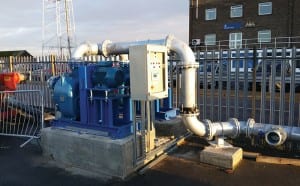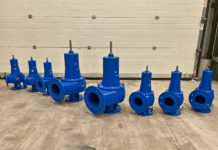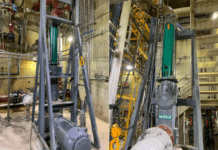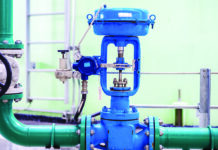Like many industrial sites that contain large areas of open space, surface water build up can prove to be a problem. At the Port of Immingham surface water had always been removed from the 1,230 acre site by a tidal flap (valve) that drained water from a series of inter-connecting chambers and discharge pits directly into the Humber Estuary. However, recurrent blockages meant ABP’s engineers were keen to find a permanent solution to the problem.
The Port of Immingham is the largest by tonnage in the UK, handling some 50 million tonnes annually, and can accommodate vessels of up to 130,000 tonnes, so maintaining full operation at all times is essential. Whilst surface water build-up was not a major threat to the Port’s operations, it was seen as a recurring problem that had to be resolved. In mid-2015, engineers at the port called in the services of pump distribution and engineering specialist AxFlow, to tackle the problem. AxFlow’s proposal was to build a surface-mounted pumping station that would drain the interconnecting chambers and pump the water into the dock.

Why this solution was chosen
AxFlow Technical Support Manager Mark Redgrove explained why this solution was arrived at: “The existing drainage system consisted of a series of underground chambers that collected the water which then drained into a main discharge pit on the lock side of the port. From there the water was discharged through the tidal flap located on a mud bank in the estuary. However, this regularly silted up, with clearing away the silt and mud having to be undertaken manually by divers.”
The pumping station is positioned over the discharge pit and comprises two Wemco WSP6 self-priming pumps, galvanised Mild Steel pipework, heated jackets for cold weather protection and a control panel complete with pulsar ultrasonic level control. “The discharge pit is approximately 1m2 so a surface mounted self-priming pump was selected as there was insufficient space in the pit to use submersible pumps,” continued Redgrove. “We also had to take into account the issue of pump maintenance, which is much easier with surface-mounted pumps. The decision to use Wemco WSP6 pumps was made on the grounds that as the run-off water contains grit and solids that collect on the docks, this pump would easily handle them as they are not affected by solids.”
Self-priming pump application space and performance
The Wemco WSP heavy duty self-priming pump is equally at ease with both clean and solids-laden liquids due to its open type two-vane impeller. Suitable for usage across a broad spectrum of applications in water and wastewater handling, the WSP has a differential head capability ranging from 3 – 42m and can deliver flowrates from 10 – 700m³/h. The two-vane impeller is manufactured in a choice of cast iron or CD4MCu with the wear plate also being made from cast iron and the casings made of ductile iron. It is this build quality that enables the pump to handle both clean and aggressive fluids, plus the solids handling capability being excellent for this range.
Self-priming pump suitability

Self priming pumps are ideally suited to any duty with a suction lift where ease of access to the pump is necessary for maintenance purposes. Whereas submersible pumps have the benefit of being primed by the liquid in which they are submerged, access can be difficult when maintenance is required.
The two 6-inch Wemco pumps have been installed by AxFlow on the edge of the pit and have suction legs descending 7.5m into the pit. The run-off water is pumped through 30m of discharge pipework that takes the water away to a point where it drops into a dummy sluice, this being a small chamber that is parallel to the lock. It is connected to the lock and as the level of the water in the lock rises and falls, so does the dummy sluice. The water run-off passes out of the dummy sluice into the lock and enters the estuary when the lock gates are opened.
Pit pointers
The discharge pit has the capacity to hold between 6- and 7m³ of water, and once it is empty it soon fills up as water from the inter-linked chambers drains into it. The design flow is 200m³/hr, which provides the dock with plenty of surplus capacity, with emptying times being between four and five minutes. Once the chamber is empty it can fill up relatively quickly depending on the rainfall. Due to the fluctuations in the volume of surface water run-off, the pumps are not operating continuously. The pumps are on duty/standby configuration in order that both pumps share the workload. When one pump has run for a period, the ultrasonic control system will switch operation to the standby pump which then becomes the duty pump. Should there be very high rainfall both pumps can operate at the same time to keep the water flowing at optimum capacity.
A legacy of ABP projects
AxFlow has undertaken a number of pump projects for ABP over the years. “This is not our first project at the Port of Immingham,” said Redgrove.
“Back in 2014 we were asked by ABP engineers to produce a pumping solution for emptying a grit chamber in a settling pit at the coal terminal where the water separates out from the grit. We installed two sets of 4-inch submersible pumps and these have worked very well.”
The new surface water pumping station was commissioned in the final quarter of 2015 and Mark Redgrove says that initial reports received indicate that it is working as expected.







